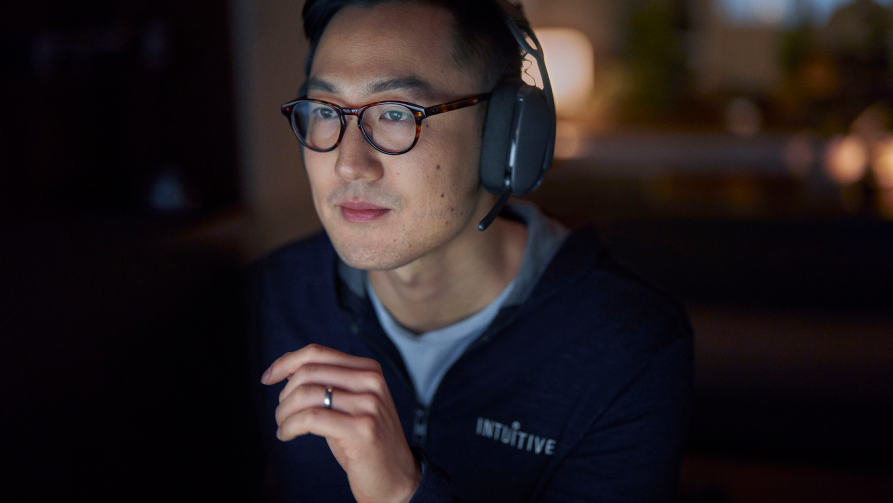

Intuitive’s robotic surgical systems are known for their extreme reliability: they have more than 99 percent “up time,” meaning that they are almost always available when surgeons and care teams need them.
But as with every complex system, problems can occasionally occur. For those situations, Intuitive has developed OnSite, a sophisticated online network that minimizes downtime by remotely connecting service engineers to customers’ robotic systems so they can begin diagnosing, and often fixing, the issue right away. About half the time, Intuitive’s technical support engineers can fix the problem remotely. Even when they can’t do this, they can often identify what the issue is, which helps field service engineers to solve the problem more rapidly. Beyond that, OnSite proactively tracks a wide range of system parameters, allowing support engineers to diagnose potential issues before they have an impact on how the system operates.
The process is similar to how IT support remotely takes control of a laptop to troubleshoot from within the device. One key difference is the level of responsiveness. Intuitive’s technical support engineers are always available, 24 hours a day, seven days a week. Almost all calls are picked up within 20 seconds.
“It’s an invaluable tool,” says Christopher Thornley, robotic surgical coordinator at Griffin Hospital in Derby, Connecticut. Thornley oversees all robotic surgeries done at the hospital, which has two da Vinci Xis. “It really streamlines the servicing and repair process.” Surgeons at the hospital use the systems in a range of specialties, including gastrointestinal and gynecology. Thornley says OnSite is enormously helpful in ensuring that robotic surgeries stay on schedule.
Worldwide, around 90 percent of Intuitive Da Vinci robotic surgical systems are connected to OnSite. If a problem occurs before, during, or after surgery, a support engineer can begin looking at the system very quickly, often within a minute or two, examining the device’s automatically generated error logs to help pinpoint the problem. As they do this, they stay on the phone with the care team member, usually a surgeon, circulating nurse, hospital engineer, or robotics coordinator, to talk them through potential adjustments.
These calls can be stressful. They may occur during procedures, and even when they don’t, care teams are typically eager to get their systems back up and running again as soon as possible so they can stay on schedule.
“It can be a lot of pressure,” says Tom Van Hoose, Intuitive’s senior director of technical support. “That’s where we rely on our intensive training. Experience is key too. The majority of our support team has been with the company for more than 10 years. Some of them have been here for twice that long.” He notes that almost every technical support engineer—the ones who answer the calls from care teams—has previously been a field engineer; this helps give them a broad understanding of how Intuitive systems work on the ground.
Van Hoose, who began at Intuitive 21 years ago, worked for several years as a support engineer, so he is deeply familiar with the demands of the job. He makes sure that his support engineers—there are about 30 in all—find effective ways to relax. “We talk with our team constantly to make sure they're monitoring and handling the stress appropriately,” he says. Van Hoose says he exercises regularly, and also tries to spend time outdoors, walking his dog or playing golf.

In addition, Intuitive focuses on hiring engineers who have the right outlook. Van Hoose says he looks for calm, empathetic people who are used to operating in high-stakes situations. Many support and field engineers come to Intuitive from the military. Eric Curtis, product manager, global field service, is a good example. Curtis, who has previously been a field engineer at the company, is a Navy veteran; for six years, he was an electrician on a nuclear attack submarine, often spending weeks at a time submerged. “You're under water,” he says. “If something goes wrong down there, it could be a real problem. You've just got to do your job.” He says he brings the same attitude to his work at Intuitive.
Beyond allowing technicians to remotely diagnose problems in real time, OnSite constantly monitors all Intuitive systems that are connected to it. This enables support engineers to diagnose potential issues long before they become realities. Curtis says this streamlines the process of monitoring and maintaining the systems. When they visit hospitals, field engineers already know exactly what kind of updating or support the system needs. So they don’t need to make as many visits. In addition, OnSite allows engineers to update system software remotely, further reducing work for field engineers and hospital staff.
Van Hoose, the senior director of support, says that in the future, OnSite will become even more capable of predicting exactly what each robotic system needs to remain operational. With the addition of artificial intelligence technology, OnSite will be even better able to provide actionable insights into how a particular Intuitive system is working, and what maintenance it might need in the future.
“Our goal is for OnSite to become even more proactive, more predictive,” he says. “The more we can do ahead of time, the easier it will be for the surgeons to do what they do best, which is focus on their patients.”
Important safety information
For important safety information, please refer to www.intuitive.com/safety. For a product’s intended use and/or indications for use, risks, full cautions, and warnings, please refer to the associated User Manual(s).